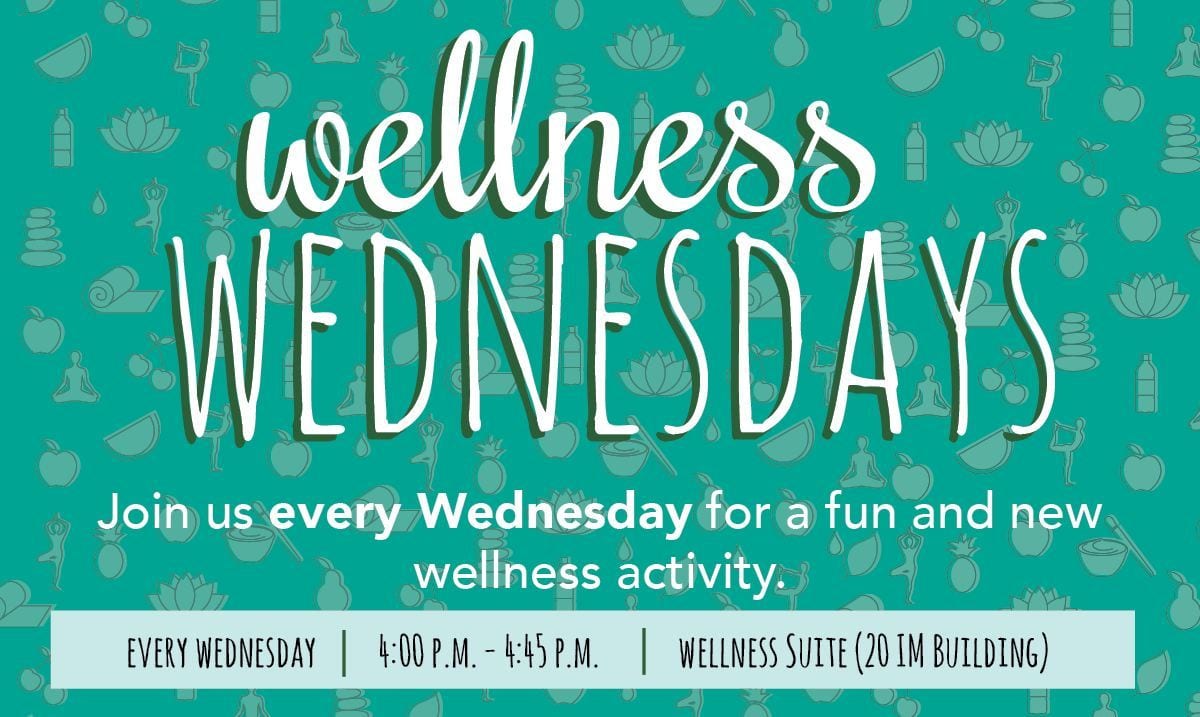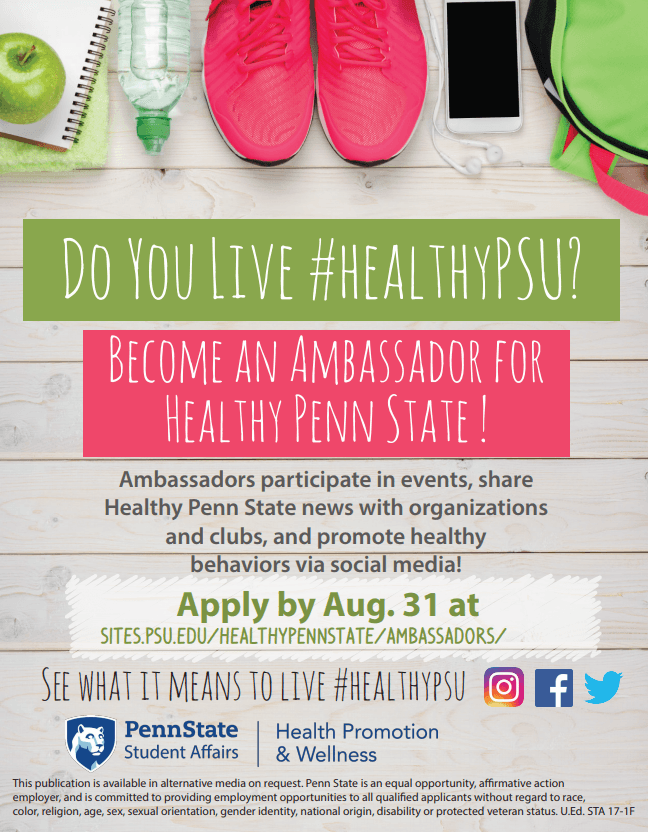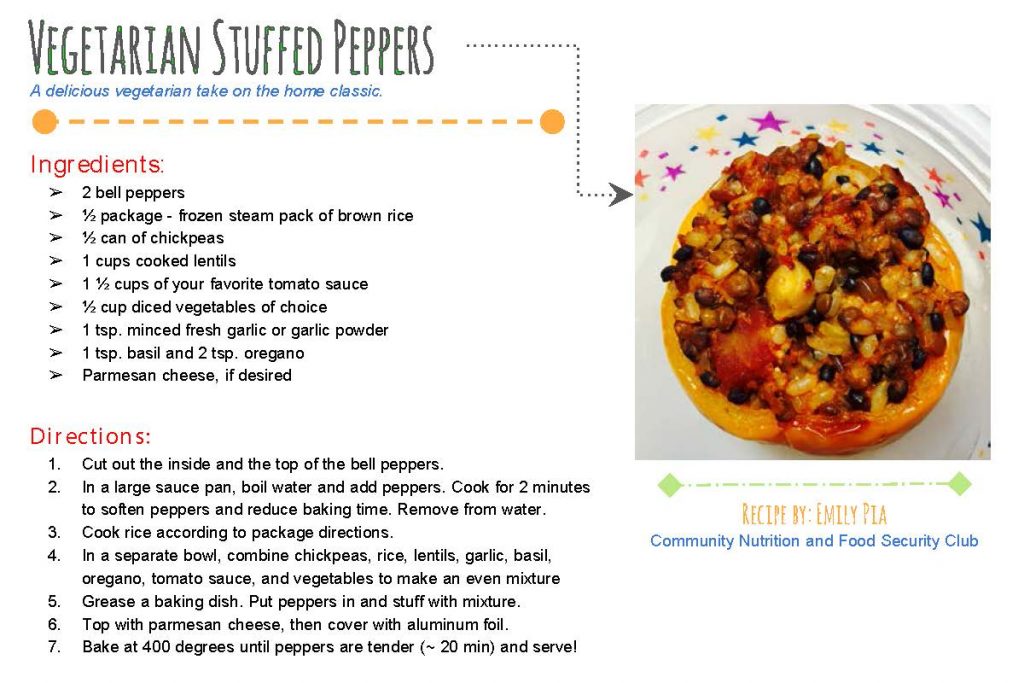It’s important to take care of yourself. This semester make your well-being a priority and treat yourself to a day of relaxation and healthy activities! Spaces are filling up for the next Wellness Retreat. Email promotinghealth@psu.edu or call 814.863.0461 to reserve your spot for the October 20th retreat. To learn more about free wellness activities, visit https://healthypennstate.psu.edu/fall-2018-wellness-activities/
Creating a Positive Nutrition Space
Your social network and schedule play a big role in the choices you make when it comes to nutrition. These choices can look different for everyone. Do your friends and family prefer to dine out or cook? Do you add meal times to your schedule or do you hope to get a meal in between other activities?
Dining out can be a great way to catch up with friends and family. However, the dining environment doesn’t always lend itself to healthy choices. Restaurants are notorious for serving large portions, heavily salted foods and high saturated fat content (1). Cooking at home can be a healthier alternative because you can control the ingredients including seasoning foods with spices other than salt and utilizing healthy fats such as olive oil or avocado oil. Plus, cooking for yourself is less expensive than dining out. Having friends and family support these choices can create a positive wellness environment.
Just as you schedule time for classes and meetings, scheduling time for meals is important to creating healthy living strategies. Food fuels your body and more specifically your brain. Taking the time to eat balanced and consistent meals and snacks can benefit your overall well-being. One study showed a significant association between happiness and consuming breakfast (2).
Creating a space to make healthy nutrition choices is important for overall wellness. Take a moment to think about whether your environment supports eating healthy. If you feel that it doesn’t and need help making changes schedule an appointment with a dietitian in Health Promotion and Wellness. Appointments are free and can be made on myUHS or by calling 814-863-0461.
- American Heart Association. Eat Fast Food. http://www.heart.org/HEARTORG/HealthyLiving/HealthyEating/DiningOut/Eating-Fast-Food_UCM_301473_Article.jsp#.W3W7iIWcGUk. Accessed August 16, 2018.
- Lesani, A., Mohammadpoorasl, A., Javadi, M., Esfeh, J., Fakhari, A. Eating and Weight Disorders – Studies on Anorexia, Bulimia and Obesity. Dec. 2016: 21(4) 645-651.
Meditation Series
Mark Agrusti of the Dharma Lions at Penn State, will lead four meditation sessions to help students learn stress management strategies. The sessions are independent of each other and students are not required to attend all four sessions. Sessions will be held from 5:15 to 6:15 p.m. in the Wellness Suite, 20 Intramural Building. Dates and topics include:
- Tuesday, Sept. 11 – Mindfulness and Stress Reduction Techniques
- Thursday, Oct. 8 – Learn to Meditate
- Tuesday, Nov. 6 – Calming the Mind with Meditation
- Tuesday, Dec. 4 – Relaxation Meditation
Wellness Wednesday
Join HealthWorks Peer Educators and Healthy Penn State Ambassadors every Wednesday during the fall semester for wellness activities. Every week this 45-minute session will feature an activity that is designed to help you reduce stress. Here are some examples of what we’ll be doing:
- Learn to destress with a body scan and belly breathing
- Create a mind jar and unplug from your phone and social media
- Go on a guided nature walk with meditation and cloud gazing
All Wellness Wednesday Wednesdays are located in the Wellness Suite (20 IM Building) from 4:00-4:45pm. We hope to see you there!
Become a Healthy Penn State Ambassador!
Are you passionate about health and wellness? Maybe you’ve recently decided to make your health a priority and are amazed at how much your life has improved. Maybe you want to encourage other students to be healthy. Wherever you are in your health journey, consider applying to become a Healthy Penn State Ambassador!
Healthy Penn State Ambassadors serve as role models for healthy behaviors on campus. They participate in outreach events for Health Promotion and Wellness (HPW) as well as promote health through social media and informal interactions with other students. Ambassadors also speak to groups, clubs, and student organizations about the HPW Wellness Services and how students can use the services to improve their health.
As a Healthy Penn State Ambassador, you will work with health promotion staff while developing your leadership skills and enhancing your resume. You will build valuable friendships and expand your professional network, all while making a difference in the health of Penn State students.
Training to become an ambassador will take place in Fall 2018. The training consists of 8 hours and will be held at times that are most convenient for the selected students. Students will learn healthy skills, health promotion strategies and motivational interviewing.
You must be able to commit to at least one semester to be a Healthy Penn State Ambassador. Requirements include attending the mandatory 8-hour training, 1 hour bi-weekly meetings and volunteering 1 to 3 hours per week (at most) to Healthy Penn State activities.
To apply, complete the application at here. The deadline to apply is August 31. If you have questions, stop by Health Promotion and Wellness in 20 Intramural Building or call (814)-863-0461. You may also contact us by e-mail at promotinghealth@psu.edu.
Fuel Your Workout
Working out is important to your physical and mental health. You might have questions about what to eat before and after workouts. I have done some research on the topic and want to share my findings with you. Eating a snack before working out in the morning will provide a boost of energy because your body has been fasting during the night. Eating a snack before working out in the late afternoon will also provide much needed energy given that you probably eat lunch several hours earlier. Experts in the field recommend that you eat something within one hour after working out to maximize recovery, if you are not planning to eat a regular meal. Below are some examples of balanced snacks and meals that will help fuel your body.
The type of food you should eat before a workout depends on the type of activity that you have planned. For strength training, aim for a snack rich in protein. This may include 6 ounces low fat Greek yogurt and ¼ cup of almonds, string cheese or an energy bar with 8 or more grams of protein (1). For a cardio workout, complex carbohydrates are a great energy source. Examples include a small box of raisins (2 tablespoons), a small banana, or one slice of whole wheat bread with a thin layer of peanut butter. Try eating these foods 30-60 minutes before working out to allow time for digestion.
If you exercise immediately before a meal like breakfast or lunch, then skip the post-workout snack and fuel your body with a healthy meal that contains quality carbohydrates and protein. Base your meal on the MyPlate guidelines to ensure that it is balanced and contains each food group (3). One example of a well-balanced meal is hard cooked eggs with a slice of whole grain toast and 100% fruit juice or oatmeal with berries and milk (2). If you workout later in the morning, try having a grilled chicken salad (with vegetables, nuts, quinoa and fruit such as apples or cranberries to provide a well-rounded meal with protein, fats, and carbohydrates) or turkey sub with whole wheat bread and a side of veggies for lunch.
If you do not have a meal planned close to your workout, plan to have a snack to replenish carbohydrate stores and repair muscles. Examples of great post workout snacks include: one tablespoon of nut butter on apple slices, 6-8 ounces of low fat chocolate milk or a string cheese with a few whole grain crackers.
Remember to hydrate and rehydrate! The American College of Sports Medicine recommends drinking 16-20 ounces of water at least 4 hours before working out and another 8-12 ounces 10 or 15 minutes after working out (4). Sip 3 to 8 ounces of water every 15 minutes during any work out that is less than 1 hour (1). Keep your body properly hydrated and fueled to get the best workout possible. We hope you have a fulfilling workout!
Written by HealthWorks member, Valerie Snell
- Wolfram, Taylor. “How to Fuel Your Workout”. Eat Right. Academy of Nutrition and Dietetics, 10 Jul. 2018, https://www.eatright.org/fitness/exercise/exercise-nutrition/how-to-fuel-your-workout
- Rosenbloom, Christine. “3 Easy Tips for Fueling Your Workout without Overdoing It.” Eat Right. Academy of Nutrition and Dietetics., 19 Oct. 2016, eatright.org/fitness/sports-and-performance/fueling-your-workout/3-easy-tips-for-fueling-your-workout-without-overdoing-it.
- https://www.choosemyplate.gov/
- Michael N. Sawka, FACSM (chair); Louise M. Burke, FACSM, E. Randy Eichner, FACSM, Ronald J. Maughan, FACSM, Scott J. Montain, FACSM, Nina S. Stachenfeld, FACSM. American College of Sports Medicine Exercise and Fluid Replacement Position Stand
Phubbing
What is phubbing?
“Phubbing” is the act of ignoring or snubbing a companion to pay attention to a phone or mobile device (1). Pretty much everyone has their smart phone in their hands these days (2). Research shows that simply the presence of a mobile phone in social settings detracts from the face-to-face interaction. Most people typically do not realize that the use of their phone–when they are talking to another person–is perceived to be negative (2).
How does phubbing affect my social interactions?
There are many benefits to social media because it serves as a way to connect with loved ones and those who are not live near by (2). Despite the fact that many individuals use their mobile devices to maintain relationships, research suggests that the presence of cell phones negatively affects in-person interactions (2). Having a phone present (not necessarily even in view) during an in-person interaction can result in less effective communication. This is especially true during meaningful interactions (2). Many students interrupt their meals or conversations with friends to check texts, emails, social media and voicemails (3). It is not surprising that this then takes a toll on carrying out a conversation, listening attentively, and developing trust (2).
What can you do?
So the next time you meet with a faculty member, supervisor or at your next student org meeting, you may want to keep your phone or laptop in your book bag. You can also turning off your phone when you are at work or hanging out with friends. Focus on enjoying the in-person social time you have with friends. Set aside certain times during the day to use social media, have phone calls, or even answer texts and emails.
Sources
- https://en.oxforddictionaries.com/definition/phubbing
- Przybylski, Andrew K., Weinstein, Netta.; Can you connect with me now? How the presence of mobile communication technology influences face-to-face conversation quality.; Journal of Social and Personal Relationships; 2012
- Geser, H. Sociology of the mobile phone. University of Zurich, Switzerland. 2002
Vegetarian Stuffed Peppers
Catching up on sleep: How to do it the right way
Make sleep a priority by working to develop healthy sleep habits. In spring 2018 the health promotion staff conducted a survey with undergrads at University Park about their health behaviors. You might be surprised to read that 41.7% of the respondents reported feeling tired or dragged out on most days of the week (1). Some students believe that pulling an all-nighter will be more helpful than getting a full night of sleep. Other students are worried that they’ll miss out on something exciting (FOMO). However, plenty of research shows that we typically need between 7-9 hours of shut-eye a night to function at our best, both academically and socially (2). Sleep plays a vital role in the consolidation of memory, which is essential for learning new information. Sleeping before studying refreshes your brain and makes it easier to form new memories, while sleeping after studying helps you retain new information (3). Additionally, sleep is essential to a strong immune system. Both sleep quality and quantity have a direct relationship to the strength of your immune system (4).
Below are some tips to help you make up for lost sleep. First and foremost, you should try to stick to a regular sleep-wake schedule each day, including weekends. Sleeping in on Saturday and Sunday will actually make it harder to fall asleep on Sunday evening. You can also try calculating your sleep debt and commit to an earlier bedtime. Calculate sleep debt by deducting the number of hours you slept from 8 (the average recommended number of hours of sleep per night). So if you slept 6 hours last night, you have 2 hours of sleep dept. Sleep debt is cumulative. If you slept 6 hours last night and 5 hours the night before, you have 5 hours of sleep debt. If your sleep debt is 5 hours, try going to bed 1 hour early for 5 consecutive nights.
Here are additional tips:
- Limit caffeine intake to three cups or 300mg daily before 2pm (5).
- Avoid alcohol three hours before bed (5).
- Exercise between 5-7pm – this enhances the depth of your sleep. Be sure to avoid strenuous activity 3 hours before bedtime (5).
- Limit television, laptop use and other electronics while you’re lying in bed. Avoid using screens 1-hour before bed (5).
- Take a hot shower or read a book to calm your mind without the stimulating effects of electronics (2).
Take the Three Week Sleep Camp challenge (6) with the help of one our staff. Adopting some of these habits can help you catch up on sleep and develop a healthy, consistent sleep pattern. If you struggle with getting enough sleep, call 814-863-0461 to schedule a free wellness session with one of our health educators.
References:
- Penn State University’s ACHA National College Health Assessment, Spring 2018
- Russo, Lucy. “Sleep Debt: Tips for Catching Up on Sleep.” Org, National Sleep Foundation, 28 Oct. 2014, sleep.org/articles/get-rid-of-sleep-debt/.
- Harvard University Medical School, Division of Sleep Medicine – http://healthysleep.med.harvard.edu/healthy/matters/benefits-of-sleep/learning-memory
- Walker, Matthew P. Why We Sleep unlocking the power of sleep and dreams. New York: Simon and Schuster, 2017. Print.
- Maas, James and Robbins, Rebecca. Sleep for Success! Indiana: AuthorHouse, 2011. Print.
- Dement, William. The Promise of Sleep. New York: Random House, 1999. Print.
Tofu Scramble
A protein-packed meal that you can eat for breakfast, lunch, or dinner!
Recipe By: Emily Pia, HealthWorks Peer Educator
Ingredients:
- ½ block firm tofu
- 1 Tbsp olive oil
- Chopped vegetables of choice (we recommend zucchini, peppers, broccoli, onions, mushrooms and tomatoes)
- ½ tsp minced garlic
- ½ avocado
- Salt, to taste
- ¼ tsp smoked paprika
- ¼ tso chili powder
- Hot sauce or sriracha, if desired
Directions:
- Drizzle olive oil and add garlic to a pan over medium heat on your stovetop.
- Add chopped vegetables.
- Squeeze tofu in your hands over the sink to reduce water content.
- Crumble into the pan.
- Add salt, paprika and chili powder to season and cook for 3 min.
- Serve with avocado and hot sauce/sriracha.




